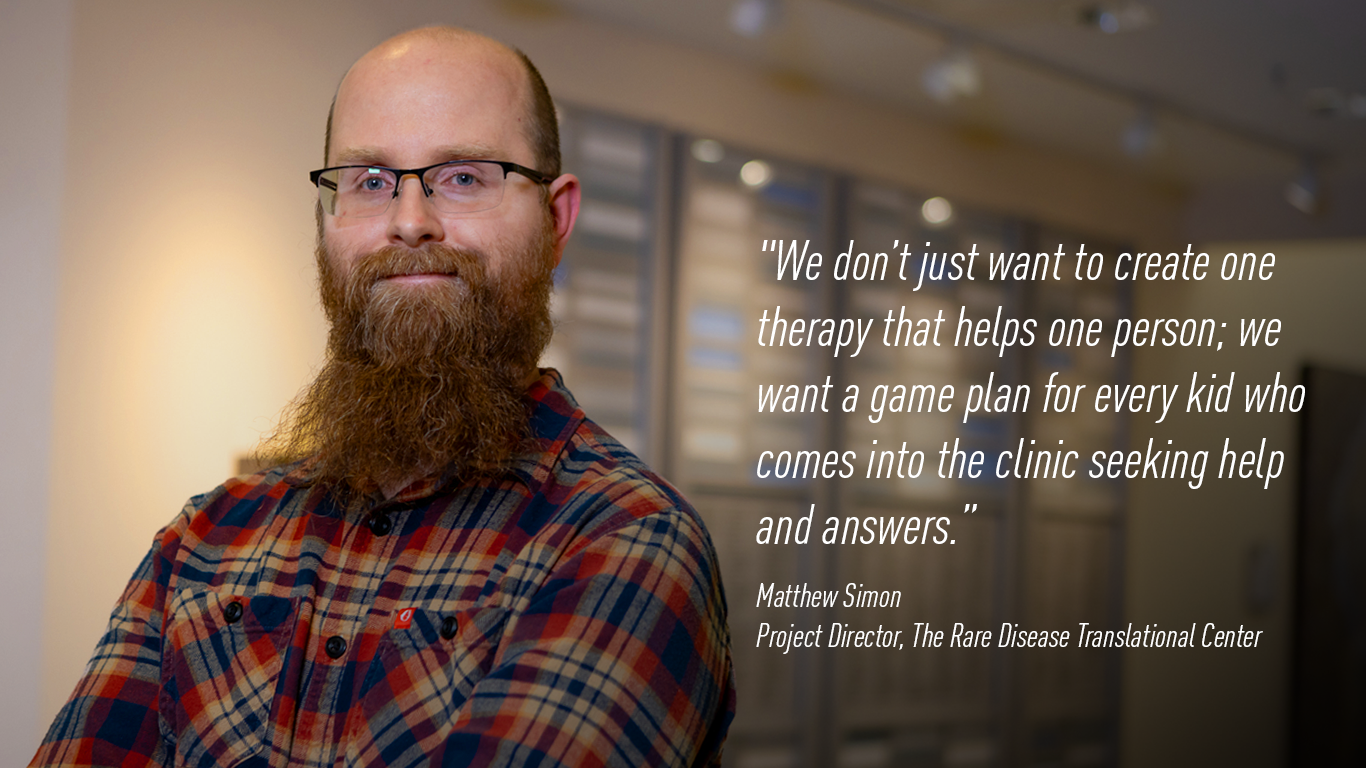
“The more we understand about the basic, critical genes involved in rare disease, the more glimpses we get into differences in overall genetic health.”
That’s Matt Simon, project director at the Rare Disease Translational Center (RDTC), explaining a key tenet of JAX’s approach to rare disease research: that discovering gene-based therapies for rare conditions has profound implications for treating more common health challenges like heart disease, cancer and Alzheimer’s disease.
The Orphan Drug Act of 1983 defines a rare disease as one that affects fewer than 200,000 people in the United States. Yet all the various rare diseases have tremendous collective impact, affecting 1 in 10 Americans and more than 350 million people worldwide. During our lifetimes, we’re likely to experience one personally, or encounter one in a family member or friend.
Simon notes that genetic mutations themselves are not rare at all. They occur in many different combinations from one individual to the next. Most don’t reach a pathological threshold as they do in patients with rare disease but are still often linked to other health challenges.
“A rare disease indicates a problem with an essential part of healthy biology,” he said. “In patients with rare disease, we see the dysfunction at its most extreme. But we can learn a lot about treating a broad spectrum of diseases by studying the most severe cases.”
Collaboration from diagnosis to clinic
Simon is a lead scientist on one such study right now. In collaboration with Ohio’s Nationwide Children’s Hospital, JAX is testing a gene therapy for PGAP3-Congenital Disorder of Glycosylation (PGAP3-CDG), a rare disease that affects just 65 people worldwide, the majority of them children. Patients typically present with developmental delays, intellectual disabilities, weak muscle tone, seizures and spasms. JAX and Nationwide are working on behalf of Moonshots for Unicorns, a nonprofit dedicated to finding a cure for the disease.
The project began in the JAX Center for Precision Genetics (JCPG) nomination portal, where foundations, clinicians and industry partners can nominate conditions to be considered for JAX’s portfolio of 50-plus ongoing genetic disease projects. RDTC scientists and the JCPG developed a mouse model for PGAP3 and confirmed that its symptoms were comparable to those observed in human patients, allowing them to quickly move to testing.
“Mouse modeling is where JAX really shines,” Simon said. “We can model these diseases in mice and test multiple potential therapies at once. We quickly discover what's working and what isn't, which enables us to tailor the treatments rapidly to move the progress forward.”
The first round of safety and efficacy testing involved introducing a healthy copy of the PGAP3 gene into the models. In less than four months, these tests identified a promising candidate that mitigates two key symptoms of PGAP3-CDG: elevated blood alkaline phosphatase and involuntary muscle contractions in the legs and arms. Next, the therapy will undergo further testing to determine the maximum safe, effective dosage and best methods for delivering it.
Conversations are also underway to develop an additional disease model for PGAP3 using a new patient allele, which will open more avenues for JAX’s cutting-edge technologies and collaborations.
JAX is actively fundraising for the RDTC, as private donations provide a level of flexibility that other funding sources do not. Simon said private gifts also allow scientists to follow unexpected leads as research unfolds.
“Philanthropy gives us wiggle room, so that if we see something really interesting that wasn’t in our original plan, we can pursue it versus having to abandon it even if we know it’s a gold-star win.”
After a rare disease like PGAP3 is diagnosed, a viable clinical treatment often can take a decade or more to implement. Simon is hopeful that these rounds of testing JAX’s PGAP3 candidate will produce a clinical-grade gene therapy that patients could receive in a small-scale safety study, potentially accelerating that timeline. If these initial studies are successful, JAX will submit a request to the U.S. Food and Drug Administration to begin preclinical work.
‘All the special ingredients in one place’
The success of the PGAP3 project to date demonstrates what’s possible when JAX puts the full weight of its scientists, resources and collaborative partners behind diseases both rare and common.
The bridge from rare disease to common health challenges begins with the idea that genes do not function in isolation. They act in concert with one another to produce different biological functions. JAX is uniquely equipped to follow the variances in what Simon refers to as the “musical choir” of our genes.
“There are many genes [other than PGAP3] involved in Congenital Disorder of Glycosylation,” he said. “Many of them fall on the same pathway. If you find a drug that treats one of them, chances are you can translate it to at least a few others, if not all. That’s how you go from treating a few hundred patients to treating thousands.”
Simon is confident the project could only have moved this quickly at JAX, where the team has access to mouse resources, connections to clinical partners pushing the boundary of gene therapy on behalf of their patients, and a world-class reputation for how well its gene therapy studies are designed.
“We have all the special ingredients in one place,” Simon said. “And we are always thinking about how to scale our discoveries. We don’t just want to create one therapy that helps one person; we want a game plan for every kid who comes into the clinic seeking help and answers.”